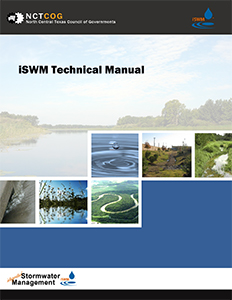The iSWM Online Technical Manual contains iSWM Technical Guidance documents that will be maintained by NCTCOG on the web. This module is referenced by the iSWM Criteria Manual and provides the technical details to meet the requirements established by each community in their iSWM Manual.
The program is split into 7 categories available for download below.

Revision Notices
This section contains notice documents for revisions to the technical manuals.
iSWM Technical Manual Documents
This section contains the most up to date manuals, notices, and schematics.
Legacy Documents
The documents in this section are not current but are provided here as a resource.
Get Updates About iSWM
Enter your email address below to be placed on the interested parties list. We will send out periodic emails regarding training opportunities and news regarding the Integrated Stormwater Management program.

